FX Traders Eye US PCE Data Amid Tariffs and Central Bank Signals | 26th September 2025

Markets Eye US PCE
Global FX markets opened Friday with a cautious tone as traders weighed fresh trade tensions, central bank moves, and the looming release of US PCE inflation data. Trump’s surprise 100% tariff on branded pharmaceuticals added a layer of geopolitical and trade risk, while the PBOC’s firmer daily fix and soft Japanese CPI readings highlighted diverging policy paths in Asia. Major currency pairs consolidated near key levels, with traders awaiting confirmation from US inflation numbers to guide the next leg in price action.
USD Forecast (DXY): Tariff Shock Boosts Dollar
Current Price and Context
As of Sept 26, 2025, the US Dollar Index (DXY) was trading around 98.50, up roughly 0.65% on the day after President Trump announced a 100% tariff on imports of branded/patented pharmaceuticals effective Oct 1. Markets interpreted the move as a significant escalation in trade policy risk, boosting the USD via safe-haven demand and expectations of policy responses that could support the dollar.
Key Drivers
Geopolitical Risks: The surprise 100% tariff on branded/patented pharmaceuticals is a major trade-policy escalation that raises geopolitical and cross-border trade tensions, increasing risk aversion and safe-haven flows into the USD.
US Economic Data: Incoming US inflation prints (notably PCE) will be watched closely — stronger-than-expected inflation could reinforce Fed tightening expectations and further support the USD.
FOMC Outcome: The Fed’s reaction function matters: if tariffs push core inflation higher or are seen as upward pressure on consumer prices, markets may price a more hawkish Fed path, supporting the dollar; conversely, if growth fears dominate, safe-haven USD flows could still lift the DXY even if Fed hikes are questioned.
Trade Policy: This tariff package is explicitly protectionist and could trigger retaliatory measures or disrupt global supply chains for healthcare inputs — a negative for global risk assets and supportive for USD strength.
Monetary Policy: Diverging central bank paths (more hawkish Fed expectations vs. cautious BoJ/PBOC responses) amplify USD upside — central bank commentary in coming sessions will be a key read-through.
Technical Outlook
Trend: Short-term trend: bullish for the USD on the immediate risk-on/risk-off shift; momentum favours further upside while headlines remain elevated.
Resistance: Immediate resistance for the DXY sits near 99.00–99.30 (round psychological area and recent swing highs).
Support: Near-term support is around 98.00, with a deeper floor near 97.50 — a close below these would be needed to question the current USD strength.
Forecast: Expect continued USD strength in the near term as markets price heightened trade uncertainty and await US inflation (PCE) and Fed commentary; intraday reversals likely on headline updates, but bias remains dollar-positive while tariffs dominate headlines.
Sentiment and Catalysts
Market Sentiment: Cautious / risk-off. Traders are likely to reduce exposure to cyclical and trade-sensitive assets (AUD, NZD, equities) and prefer USD and other safe havens until policy clarity or de-escalation emerges.
Catalysts: Key near-term catalysts include the US PCE inflation release, Fed speakers and minutes, any official clarification or rollback on the tariff measure, and potential retaliatory responses from major trade partners. Corporate guidance from large pharma firms (on cost pass-through or supply-chain moves) could also feed into sentiment.
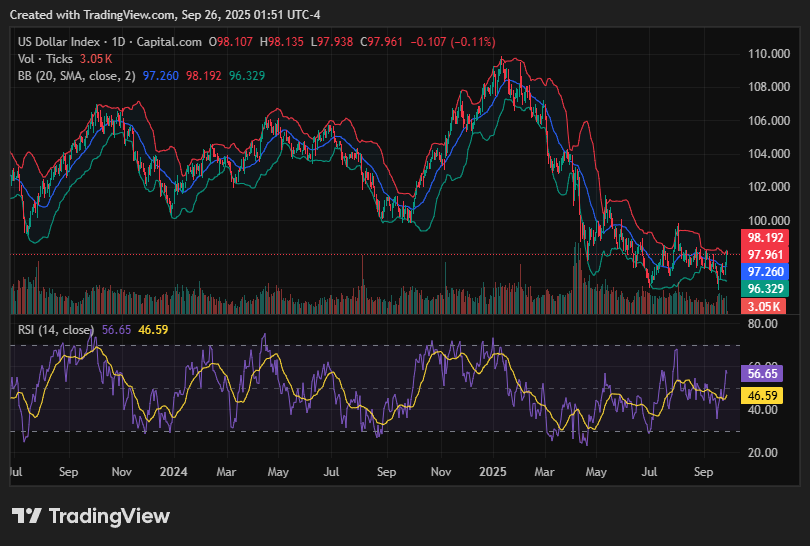
CNY Forecast: PBOC Fix Signals Yuan Weakness
Current Price and Context
On Sept 26, 2025, the People’s Bank of China (PBOC) set the USD/CNY reference rate at 7.1152, slightly weaker than the prior fix of 7.1118. The modest upward adjustment indicates Beijing’s tolerance for a softer yuan amid slowing domestic growth and external trade headwinds. While the move was not a sharp devaluation, it underscores cautious monetary calibration as authorities balance capital flows with economic support measures.
Key Drivers
Geopolitical Risks: Ongoing US-China trade tensions, amplified by Trump’s fresh tariffs on pharmaceuticals, create a backdrop of uncertainty, keeping pressure on the yuan.
US Economic Data: Stronger-than-expected US data could widen the yield gap and put further depreciation pressure on CNY, as capital flows favor USD assets.
FOMC Outcome: A more hawkish Fed stance relative to PBOC easing maintains upward bias in USD/CNY.
Trade Policy: Tariff headlines directly weigh on sentiment toward China’s export outlook, reducing investor appetite for the yuan.
Monetary Policy: The PBOC’s guided weakness highlights a willingness to support growth through easier conditions, even at the cost of gradual yuan softness.
Technical Outlook
Trend: Near-term bias is upward for USD/CNY following the slightly weaker fix.
Resistance: Next upside resistance is near 7.1250, with a breakout targeting 7.1500 if USD strength persists.
Support: Initial support lies around 7.1000, followed by stronger support at 7.0850.
Forecast: Expect controlled yuan depreciation in the short term, with the PBOC preventing sharp volatility but tolerating a gradual climb in USD/CNY.
Sentiment and Catalysts
Market Sentiment: Cautious toward the yuan, with traders wary of policy divergence and external trade risks.
Catalysts: The next key catalysts will be the US PCE inflation release, PBOC liquidity operations, and potential escalation in US-China trade rhetoric.
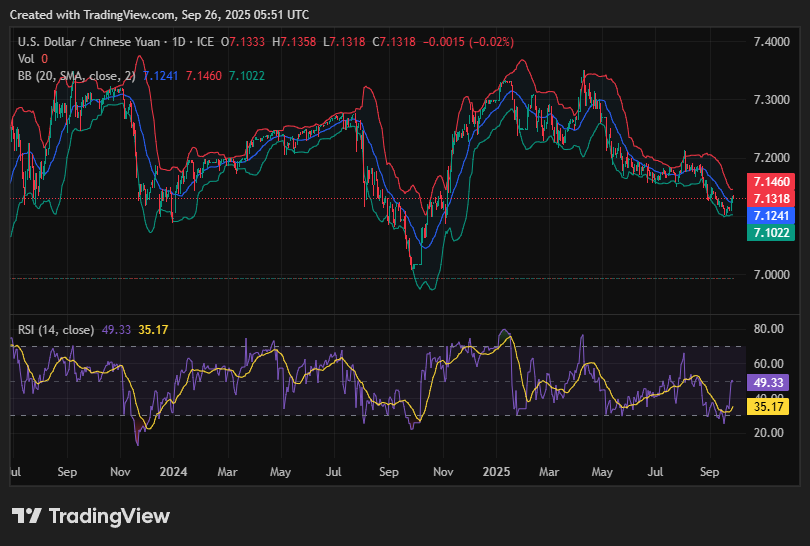
NZD Forecast: Kiwi Extends Losses Ahead of PCE
Current Price and Context
NZD/USD extended losses toward 0.5750, pressured by broad USD strength and investor caution ahead of the US PCE inflation report. The pair has been under persistent selling pressure this week, reflecting diverging Fed–RBNZ policy expectations and global risk aversion. Traders are reluctant to add long positions until clearer signals emerge from US inflation data and central bank guidance.
Key Drivers
Geopolitical Risks: Rising US trade tensions add to global risk-off sentiment, weighing on high-beta currencies like the Kiwi.
US Economic Data: The upcoming PCE inflation report is pivotal — a hotter print could reinforce USD gains, pushing NZD/USD lower.
FOMC Outcome: If the Fed maintains a hawkish bias, the policy divergence against the RBNZ will deepen, keeping pressure on NZD.
Trade Policy: US tariffs amplify risk aversion and indirectly hit commodity-linked currencies like NZD, which is sensitive to global trade demand.
Monetary Policy: The RBNZ is seen on hold or leaning dovish compared to the Fed, keeping the policy spread unfavorable for NZD.
Technical Outlook
Trend: Short-term trend is bearish, with sellers firmly in control.
Resistance: First resistance lies at 0.5800, then 0.5850.
Support: Immediate support is near 0.5730, with a key downside level at 0.5700.
Forecast: Bias remains for a test of 0.5700 in the near term if US data surprises on the upside; rebounds likely capped below 0.5850.
Sentiment and Catalysts
Market Sentiment: Negative toward NZD, with cautious positioning ahead of PCE and amid a stronger USD backdrop.
Catalysts: US PCE inflation data, Fed commentary, and China-related headlines (given NZD’s sensitivity to Chinese demand) will drive the next move.
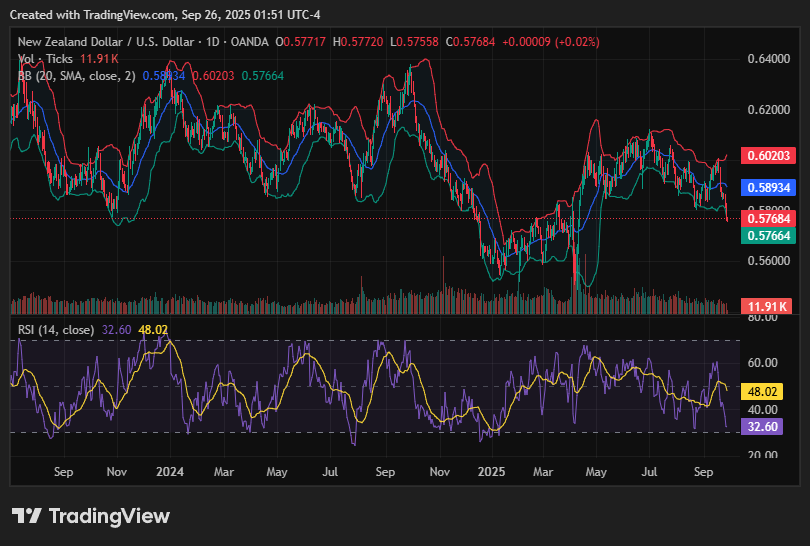
JPY Forecast: Soft CPI Weighs on Yen Outlook
Current Price and Context
The Japanese Yen remained under pressure as USD/JPY held firm above 151.00, with softer Tokyo CPI reinforcing doubts over near-term Bank of Japan (BoJ) tightening. Weak inflation momentum suggests policymakers may delay or soften their rate normalization path, keeping yield differentials wide versus the US. Risk-off sentiment from US tariff headlines provided only limited support, underscoring the Yen’s struggle to attract safe-haven flows.
Key Drivers
Geopolitical Risks: US tariff escalation typically supports the Yen as a safe haven, but weak domestic inflation limits its appeal relative to the USD.
US Economic Data: The upcoming US PCE inflation release could widen the US-Japan yield gap further if inflation prints strong.
FOMC Outcome: Fed policy divergence remains stark — hawkish Fed signals would add to USD/JPY upside.
Trade Policy: US trade tensions may add volatility, but Yen’s muted safe-haven response reflects investor focus on BoJ policy.
Monetary Policy: The BoJ faces renewed uncertainty on timing of its next hike; dovish expectations undermine JPY demand.
Technical Outlook
Trend: Short-term trend is bullish for USD/JPY, reflecting sustained dollar strength and weak JPY fundamentals.
Resistance: First resistance is near 151.80, with further upside toward 152.50.
Support: Immediate support lies at 150.50, followed by 150.00.
Forecast: Unless BoJ signals shift hawkishly, USD/JPY is likely to extend gains, testing 152.00 if US data reinforces USD strength.
Sentiment and Catalysts
Market Sentiment: Bearish on JPY — safe-haven demand is subdued, while yield differentials continue to dominate flows.
Catalysts: Key catalysts are the US PCE inflation data, BoJ commentary on inflation outlook, and broader trade-related risk headlines.
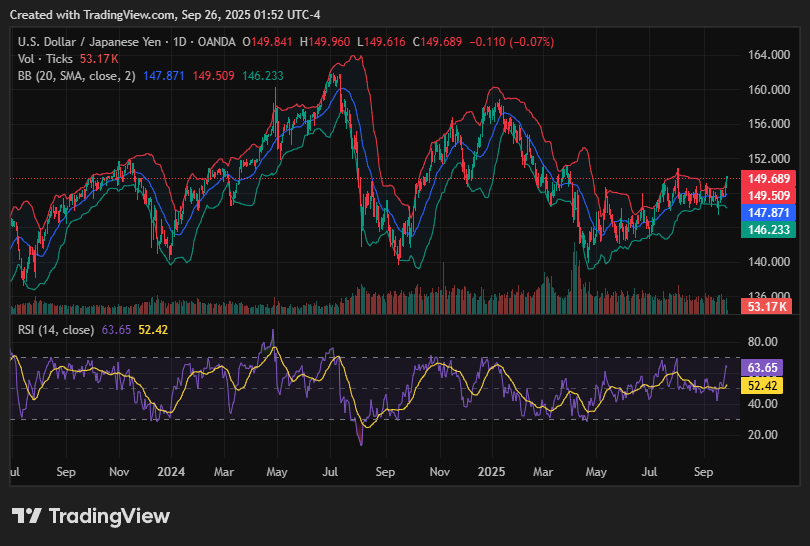
CAD Forecast: Loonie Holds Weak Near 1.3950
Current Price and Context
USD/CAD traded steadily near 1.3950, consolidating recent gains as traders awaited the US PCE inflation release. The pair reflects a mix of broad USD strength, cautious risk sentiment, and subdued oil prices that limit Canadian Dollar support. Market positioning remains cautious, with investors reluctant to fade USD gains ahead of key US data.
Key Drivers
Geopolitical Risks: US tariff shocks dampen global trade outlook, indirectly weighing on commodity-linked currencies like CAD.
US Economic Data: The upcoming PCE inflation data is the primary driver — a strong print could fuel USD/CAD upside.
FOMC Outcome: A hawkish Fed stance versus a neutral Bank of Canada outlook favors continued USD/CAD strength.
Trade Policy: Tariff-driven global demand risks could weaken oil sentiment, limiting CAD’s ability to recover.
Monetary Policy: BoC is expected to remain on hold, creating a policy divergence with the Fed that supports USD/CAD above key levels.
Technical Outlook
Trend: Short-term trend is bullish for USD/CAD, with upside momentum intact.
Resistance: Next resistance stands at 1.4000, a key psychological level.
Support: Initial support lies at 1.3900, followed by 1.3850.
Forecast: Expect consolidation between 1.3900–1.4000 in the near term, with a breakout higher possible if US inflation surprises on the upside.
Sentiment and Catalysts
Market Sentiment: Neutral-to-bullish USD/CAD bias — traders are cautious but lean toward further USD strength.
Catalysts: US PCE inflation release, oil price movements, and BoC commentary will be the main drivers in the coming sessions.
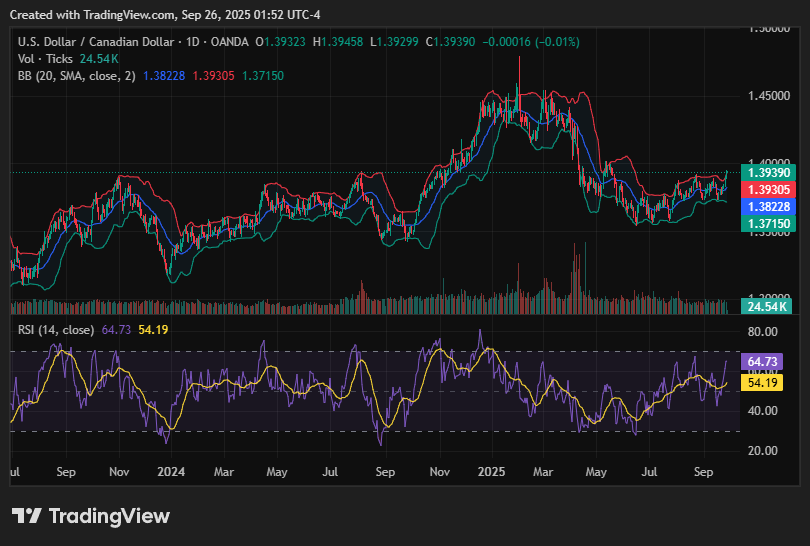
Wrap-up
In summary, FX sentiment remains cautious and data-driven, with geopolitical shocks and central bank signals adding to the uncertainty. The US PCE inflation release will likely dictate near-term USD direction, influencing gold, commodity-linked currencies, and broader risk appetite. Traders should remain alert to trade policy headlines and monetary policy cues, as these catalysts could amplify volatility across the board.
Ready to trade global markets with confidence? Join Moneta Markets today and unlock 1000+ instruments, ultra-fast execution, ECN spreads from 0.0 pips, and more! Start now with Moneta Markets!





















